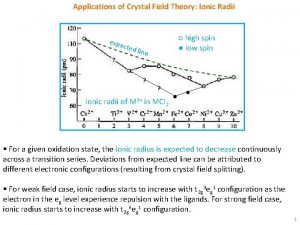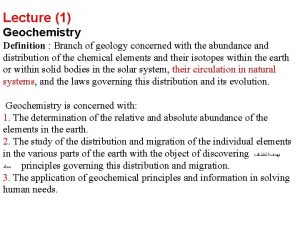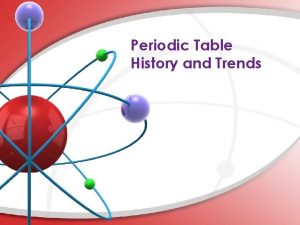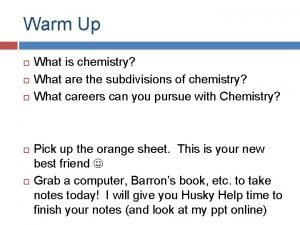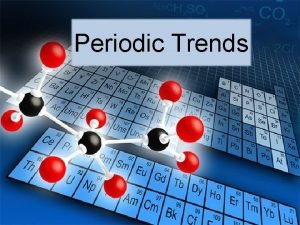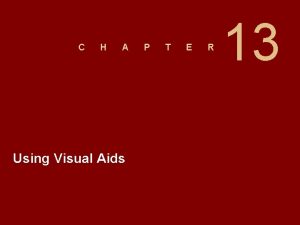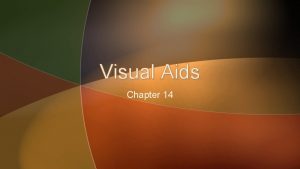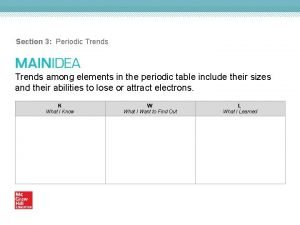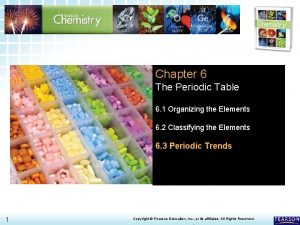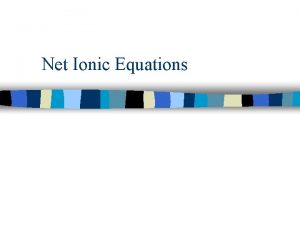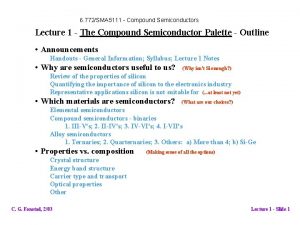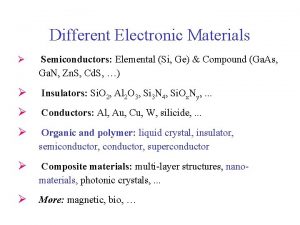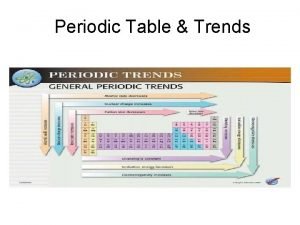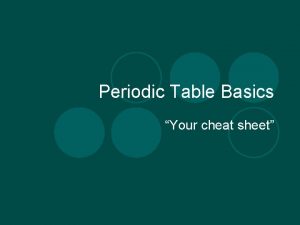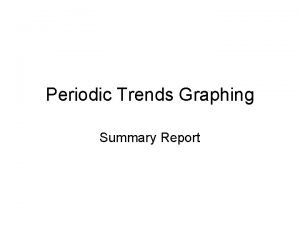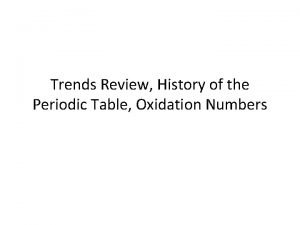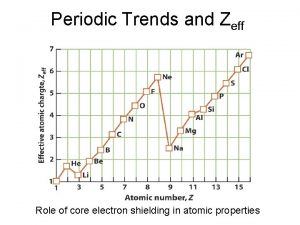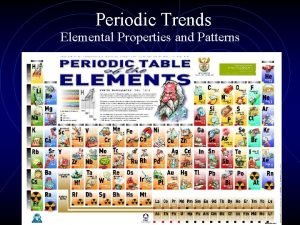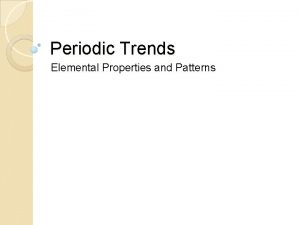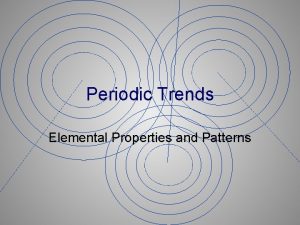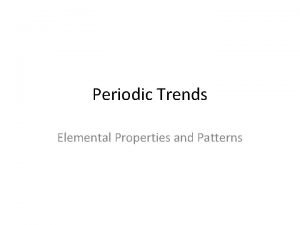Periodic Trends Elemental Properties and Patterns Ionic Radii


























- Slides: 26

Periodic Trends Elemental Properties and Patterns (Ionic Radii, Electron Affinity, Electronegativity)

A Different Type of Grouping • Besides the 4 blocks of the table, there is • • another way of classifying element: Metals Nonmetals Metalloids or Semi-metals. The following slide shows where each group is found.

Metals, Nonmetals, Metalloids

Metals, Nonmetals, Metalloids • There is a zig-zag or staircase line that divides the table. • Metals are on the left of the line, in blue. • Nonmetals are on the right of the line, in orange.

Metals, Nonmetals, Metalloids • Elements that border the stair case, shown in purple are the metalloids or semimetals. • There is one important exception. • Aluminum is more metallic than not.

Metals, Nonmetals, Metalloids • • • How can you identify a metal? What are its properties? What about the less common nonmetals? What are their properties? And what is a metalloid?

Metals • Metals are lustrous (shiny), malleable, ductile, and are good conductors of heat and electricity. • They are mostly solids at room temp. • What is one exception?

Nonmetals • Nonmetals are the opposite. • They are dull, brittle, nonconductors (insulators). • Some are solid, but many are gases, and Bromine is a liquid.

Metalloids • Metalloids, aka semi-metals • • are just that. They have characteristics of both metals and nonmetals. They are shiny but brittle. And they are semiconductors. What is our most important semiconductor?

Electron Affinity • What does the word ‘affinity’ mean? • Electron affinity is the energy change that occurs when an atom gains an electron (also measured in k. J)

Electron Affinity • Electron affinity is exothermic if there is an empty or partially empty orbital for an electron to occupy. • If there are no empty spaces, a new orbital must be created, making the process endothermic. • This is true for the alkaline earth metals and the noble gases.

Electron Affinity • Your trend should look like this: + +

Metallic Character It is not better to give… • This is simply a relative measure of how easily atoms lose or give up electrons. • Your trend should look like this:

Electronegativity • Electronegativity is a measure of an atom’s • • • attraction for another atom’s electrons. It is an arbitrary scale that ranges from 0 to 4. The units of electronegativity are Paulings. Generally, metals are electron givers and have low electronegativities. Nonmetals are electron takers and have high electronegativities. What about the noble gases?

Electronegativity • Your trend should look like this: 0

What Electronegativity Tells Us • Electronegativity tells us what type of bond two or more elements will form • Large difference in electronegativity between two elements = ionic bond • Small difference in electronegativity between two elements = covalent bond

Bonds • Covalent Bond – Sharing of electrons…weaker of the two bonds • Ionic Bond – Stronger bond…when an element with a low electronegativity “gives” an electron to an element with high electronegativity


Overall Reactivity • This ties all the previous trends together in one package. • However, we must treat metals and nonmetals separately. • The most reactive metals are the largest since they are the best electron givers. • The most reactive nonmetals are the smallest ones, the best electron takers.

Overall Reactivity • Your trend will look like this: 0

The Octet Rule • The “goal” of most atoms (except H, Li and Be) is to have an octet or group of 8 electrons in their valence energy level. • They may accomplish this by either giving electrons away or taking them. • Metals generally give electrons, nonmetals take them from other atoms. • Atoms that have gained or lost electrons are called ions.

Ions • When an atom gains an electron, it becomes negatively charged (more electrons than protons ) and is called an anion. • In the same way that nonmetal atoms can gain electrons, metal atoms can lose electrons. • They become positively charged cations.

Ions • Here is a simple way to remember which is the cation and which the anion: This is Ann Ion. She’s unhappy and negative.

Ionic Radius • Cations are always smaller than the original atom. • The entire outer Priciple Energy Level is removed during ionization. • Conversely, anions are always larger than the original atom. • Electrons are added to the outer PEL.

Cation Formation Effective nuclear charge on remaining electrons increases. Na atom 1 valence electron 11 p+ Valence elost in ion formation Remaining e- are pulled in closer to the nucleus. Ionic size decreases. Result: a smaller sodium cation, Na+

chloride ion is Anion Formation Aproduced. It is larger than the original atom. Chlorine atom with 7 valence e 17 p+ One e- is added to the outer shell. Effective nuclear charge is reduced and the ecloud expands.
 Nuclear charge definition
Nuclear charge definition Periodic trends in elemental properties
Periodic trends in elemental properties Periodic trends in elemental properties
Periodic trends in elemental properties Atomic radius increases when
Atomic radius increases when Periodic trends in properties of elements
Periodic trends in properties of elements Boron group number
Boron group number Application of crystal field theory
Application of crystal field theory Geochemistry definition
Geochemistry definition Periodic trends in properties of elements
Periodic trends in properties of elements نصف القطر الذري
نصف القطر الذري 12 electrons
12 electrons A visual aid used to show statistical trends and patterns.
A visual aid used to show statistical trends and patterns. A visual aid used to show statistical trends and patterns
A visual aid used to show statistical trends and patterns Ionic radius periodic table trend
Ionic radius periodic table trend Ionic bond strength trends
Ionic bond strength trends Trends for ionic charge
Trends for ionic charge Net ionic equation
Net ionic equation Elemental and compound semiconductors
Elemental and compound semiconductors Elemental and compound semiconductors
Elemental and compound semiconductors Atomic radius and electronegativity
Atomic radius and electronegativity Periodic table cheat
Periodic table cheat Ap chemistry chapter 7 atomic structure and periodicity
Ap chemistry chapter 7 atomic structure and periodicity Graphing periodic trends
Graphing periodic trends Oxidation trends periodic table
Oxidation trends periodic table Electronegativity meaning
Electronegativity meaning Trend of zeff in the periodic table
Trend of zeff in the periodic table Periodic trends activity worksheet
Periodic trends activity worksheet






